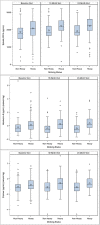Association between alcohol use and inflammatory biomarkers over time among younger adults with HIV-The Russia ARCH Observational Study
- PMID: 31437155
- PMCID: PMC6705834
- DOI: 10.1371/journal.pone.0219710
Association between alcohol use and inflammatory biomarkers over time among younger adults with HIV-The Russia ARCH Observational Study
Abstract
Background: Biomarkers of monocyte activation (soluble CD14 [sCD14]), inflammation (interleukin-6 [IL-6]), and altered coagulation (D-dimer) are associated with increased mortality risk in people with HIV. The objective of the Russia Alcohol Research Collaboration on HIV/AIDS (ARCH) study was to evaluate the association between heavy alcohol use and inflammatory biomarkers over time.
Methods: The study sought antiretroviral therapy naive participants with HIV (n = 350) and assessed them at baseline, 12 and 24 months. Linear mixed effects models were used to determine whether heavy drinking (self-report augmented by phosphatidylethanol [PEth], an alcohol biomarker) was longitudinally associated with IL-6, sCD14 and D-dimer adjusting for potential confounders (e.g., demographics, HIV factors, comorbid conditions).
Results: Participants' baseline characteristics were as follows: 71% male; mean age of 34 years; 87% self-reported hepatitis C; and 86% current smokers. Mean log10 (HIV RNA) was 4.3 copies/mL. Heavy alcohol use, based on National Institute of Alcohol Abuse and Alcoholism risky drinking criteria and PEth (versus non-heavy alcohol use) was associated with higher sCD14 (adjusted mean difference 125 ng/mL [95% CI: 42, 209]), IL-6 (ratio of means 1.35 [95% CI: 1.17, 1.55] pg/mL), and D-dimer (ratio of means 1.20 [95% CI: 1.06, 1.37] ug/mL) across the two-year follow-up.
Conclusion: Among HIV+ adults, current heavy alcohol use is associated with higher sCD14, IL-6 and D-dimer over time. Since these biomarkers are associated with mortality, interventions to mitigate effects of heavy drinking on these immune processes merit consideration.
Conflict of interest statement
An employee of the funder (K. Bryant) is a co-author on this manuscript and helped guide analysis, interpretation and presentation of data and participated in the decision to submit the manuscript for publication. Debbie Cheng serves on Data Safety Monitoring Boards for Janssen Research & Development. This does not alter our adherence to PLOS ONE policies on sharing data and materials. The remaining authors report no declarations of interest.
Figures








References
-
- Cook RT. Alcohol abuse, alcoholism, and damage to the immune system—a review. Alcohol Clin Exp Res. 1998;22(9):1927–42. . - PubMed
-
- Dolganiuc A, Kodys K, Kopasz A, Marshall C, Mandrekar P, Szabo G. Additive inhibition of dendritic cell allostimulatory capacity by alcohol and hepatitis C is not restored by DC maturation and involves abnormal IL-10 and IL-2 induction. Alcohol Clin Exp Res. 2003;27(6):1023–31. 10.1097/01.ALC.0000071745.63433.32 . - DOI - PubMed
Publication types
MeSH terms
Substances
Grants and funding
LinkOut - more resources
Full Text Sources
Medical
Research Materials

